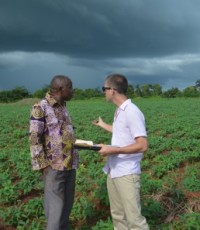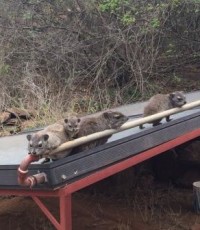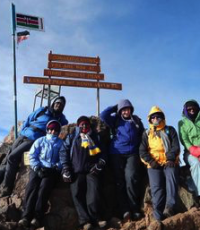March - April 2015
Dear Friends,
With spring finally here in Princeton, another busy season for PiAf has begun! We’re in the midst of placing another incredible group of Fellows for our 2015-16 fellowship year. We look forward to finalizing these placements and introducing you to our new class of Fellows and new organizations in the next Fellows Flyer.
As you’ll see in this month’s Flyer, our Fellows are also as busy as ever on the African continent – whether it’s teaching English to secondary school students in Botswana or surveying corn farmers in Ghana. Thankfully, they all got a welcome break during this year’s mid-year Fellows’ Retreat, held from March 6 to 10 in Jinja, Uganda. At the retreat, 47 of our Fellows, along with PiAf staff members, alumni, and PiAf Co-Founder Frank Strasburger, came together for a weekend of reflection, community, and professional development (and plenty of fun, too!). This edition of the Flyer contains photos of the retreat and other photos of our Fellows and alumni meeting up across the African continent. Check them out below!
As always, we hope you enjoy this edition of the Fellows Flyer!
Warm regards,
Katie Henneman
Executive Director
PiAf Connections
Please click below to check out pictures of our Fellows, Alums and other members of the PiAf family meeting up at home and around Africa.
Notes from the Field
By John Firestone, 2014-15 Fellow with Olam International in Ghana
5:00 AM: Daniel, my driver, gets up to go check on his “baby.” It’s the name I have given the car that he cares for like it is his own blood. I can’t see the sun so my eyes close for another hour before the early morning commotion wakes me up again.
6:15 AM: Breakfast of eggs, toast and Lipton. No words are spoken as Daniel and I enjoy the morning coolness and relative quiet. Is it the tea or the ever-blazing Ghanaian sun that is warming me? Daniel and I take our last sip of tea, of peace, and give each other the nod.
6:45 AM: On the road for another day of surveying corn farmers. Daniel’s on the lookout for anyone walking who is wielding a cutlass… a dead giveaway that they are a farmer. I am searching for farm roads, usually overgrown with brush and unnoticeable until we are speeding past. In a country where 70% of the population claims “agriculture” as their occupation, it doesn’t take long to locate our first interviewee. By now Daniel and I are synced. He knows the information I am looking for and how to best extract it. After exchanging pleasantries, a requirement for conversation here, unfortunately often forgotten elsewhere, we can tell if the interview will be held in English or if I will need Daniel’s translation assistance. We try to make it quick as everyone has more work to do, but never too quick as to not leave time for some joking around. While I am conducting this interview for a work-related reason, the interview means nothing personally if I don’t know about this individual’s life….“How old are your children…. what kind of shop does your wife have….of course I eat fufu!”
7:05 AM – 6:00 PM: Repeat, stopping only for roasted plantains, bofrots and, of course, fufu.
6:15 PM: As the sun is setting we always seem to find ourselves in a beautiful, remote area speaking with a family. After a long day of ‘corn’ talk, these last conversations tend to seamlessly meander through other social, political or family issues. By the end of many, I am being asked for my opinion on some deeply personal questions that any parent/spouse/sibling would have. The ‘problems’ I have been researching all day take a backseat to the everyday hurdles and successes we all experience. What a beautiful sunset…
8:00 PM: Arrive at a new guesthouse for the night and hope they are still serving food, or at least a cold beer. Daniel and I chat and laugh about the events of the day and make friends with the employees.
10:00 PM: Lights out…I hope the fan works.
…
Sometimes it is easy to let work, traffic, no electricity or discomfort blind you from the beautiful world and experiences around you. We often forget that people and our relationships are what truly make life special. It is these interactions and connections that have made this time in Ghana truly special.
Notes from the Field
By Sally Goodman, 2014-15 Fellow with Mpala Research Centre & Wildlife Foundation in Kenya
Kind of like a year-long safari is often part of my answer to questions about what life is like living at a research center on Kenya’s Laikipia plateau. Far from Nairobi’s crowds and unbearably busy streets, traffic at Mpala takes on a different form. Towering giraffes roam the dusty roads, tiny dik diks dart in front of cars, and slow-moving herds of livestock cause the biggest backups. Each animal has contributed to my experience living and working at Mpala.
Hyrax: My favorite! I’ve touched nine (an Mpala record). Though most wouldn’t guess it, this small, rodent-like creature is actually one of the closest living relatives to elephants. They may make an exceptionally loud and irritating screeching noise, but I am particularly fond of these little guys, one of whom likes to poke his nose into my office and watch me work during days spent at the computer.
Lion: The king of the jungle doesn’t show his face much around Mpala, and my interactions with these elusive cats are limited to two occasions, both of which included some one-on-one cuddle time. I have been fortunate to accompany the lion research team on two missions to dart and collar female lions in order to track their movements through GPS technology.
Elephant: When an elephant hurt with a poacher’s bullet wandered onto Mpala, Kenya Wildlife Service vets came out to sedate the animal and try to clean its wound. Though massive and dangerous creatures, petting the rough skin of an injured elephant also makes one realize how vulnerable they are.
Vervet Monkey: These sneaky critters are becoming increasingly comfortable around the human community at Mpala. One called Chapati likes to steal bananas when you turn your back at the breakfast table!
Hornbill: The real-life Zazu enjoys eating peanuts from my hand.
Grevy’s zebra: As one of Laikipia’s iconic endangered species, students whom I teach in Northern Kenya Conservation Clubs learn to respect and protect the Grevy’s.
Chicken: Chickens appear to wander free in the Mpala staff village, where I am doing surveys on household cooking-fuel use with families who have purchased a locally-made Wonderbag — a heat retention cooker. I will use data collected from the surveys to determine the effectiveness of these eco-friendly cookers in saving fuel, time, and doctor visits.
Notes from the Field
By Berhan Hagos, 2014-15 Fellow with Maru-a-Pula in Botswana
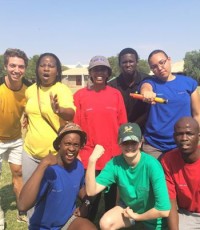
Berhan (top row, center) and fellow MaP Fellow Lauren Richardson (top row, far right) participating in the teacher relay race at MaP’s Sports Day.
I joined the teaching staff of Maru-a-Pula School (MaP) in early September and was welcomed by the blistering heat and my fellow PiAf colleagues. Six months into my fellowship the heat persists, regularly creeping well over 100 degrees Fahrenheit, but I now know which paths around campus will shield me from the relentless rays as I scurry to my next lesson. Although I enjoyed a gradual transition into life in Gaborone, I experienced a fair amount of growing pains to fit into my role as teacher. Prior to my work at MaP, my exposure to the field of education was limited to my personal experiences as a student and a few undergraduate courses on education systems. Hence, I endured a sharp learning curve in practicing the art of lesson planning and classroom management, which reiterated to me the complexity of friendships and social politics of preteen/teen culture. During my first few weeks, there were days I would leave a lesson feeling exhilarated by how responsive my students had been to the material we covered, and some days it was clear that I needed to reevaluate my approach. As the months have passed, I have embraced the routine of lesson planning, teaching, grading and facilitating enrichment and service projects with more ease and comfort thanks in great part to my students.
In ruminating on my time thus far as a Fellow, I realize that some of my greatest moments of learning have been inspired by people who stand just under 5 feet tall and average about 14 years of age. In teaching a history course on the colonization of the African continent, I relearned the material through a more nuanced lens because of the questions and perspectives my students held. Through my responsibilities as a boarding house assistant, I’ve had the pleasure of developing a close bond with the girls who are boarders. These young women speak with such sincerity and exude a liberating sense of self and confidence that makes them a great source of support for one another. I think as adults we often romanticize youth as carefree, and although there is a degree of truth to that, it doesn’t take away from the struggle that is growing up. In learning how to navigate relationships with colleagues, peers and students as well as facilitating safe learning spaces in which all of these dynamics come together, it is critical that I am a powerful listener and observer first.
The grace of the students and staff at MaP has made Gaborone an exceptionally nurturing environment for me as a young professional.
Notes from the Field
By Hilary Kinka, 2014-15 Fellow with Population Services International in Kenya
Forever the goal-setter, I left for Nairobi with a list of items to achieve during my fellowship year with PSI. Amidst the career-related targets of bolstering my exposure to public health work and gaining M&E skills, was a personal challenge: climb Mount Kenya. I’d never summited a mountain before, and last week, I did just that.
Mt. Kenya is an extinct volcano, now surrounded by a National Park that is also a UNESCO heritage site. The second highest mountain in Africa (second to Mt. Kilimanjaro), I imparted on a 5-day trek to reach the third highest summit, Lenana Peak.
A group of 6, we were accompanied by eight porters (six to carry our bags, and two to carry food and cooking supplies), one cook, and one guide. Although the porters do schlep all but your daypack, this is not the time to over-pack; two base outfits with many warm layers will carry you through… particularly since there are no showers, so a constant state of dirtiness is inevitable.
Starting at 2,650 meters, we climbed to 4,985m, and then down a new route to end at 2,100m. We stayed in bandas – basic buildings with tin roofs – in rooms teeming with bunk beds, adjacent to long halls packed with picnic tables where our porters served us meals.
As a Fellow in a major East African city, it’s rare to be completely disconnected from the world. However, after day 1 of the trek, there is no phone or internet service, forcing you to fully experience the beauty of the hike. Each day, we encountered diverse terrain, starting on a dirt road in a construction zone, and progressing through tall, hairy vegetation that looked as if it had been taken straight from a Dr. Seuss book, icy scree, a vertical bog with koosh ball-like bushes surrounded by rocky outcrops, and a shaded forest.
On the summit day, we drowsily peeled ourselves from our warm sleeping bags at 2am, and layered on nearly every article of clothing we brought on the trip for warmth. Armed with biscuits, instant coffee, and headlamps, we began the 4-hour trek to Lenana peak. It was slow going due to the altitude and steep, icy conditions. Just as the sun rose and we hoisted ourselves up the final rock scramble, we noticed how close to the edge of a cliff we had been hiking… and were grateful for the early morning darkness.
The summit itself was so bone-chillingly cold that we wanted to leave immediately after arriving – we nearly forgot to take a group picture in our eagerness to begin the rocky descent. The most intense day by far, once we reached the next banda, thawed out, and had our fill of hot tea, eggs, and sausage, the long, tired faces melted into grins of accomplishment, and then fits of laughter as we recalled each person’s “best” moments of the day.
While my primary intention in accepting this fellowship was career-related, the Mount Kenya trek has certainly punctuated my 9 months in Kenya thus far. Fully experiencing the country or region in which you are based – in the most meaningful way for you, personally – significantly enriches the fellowship.
Notes from the Field
By Meredith Strike, 2014-15 Fellow with eleQtra (InfraCo) in Uganda
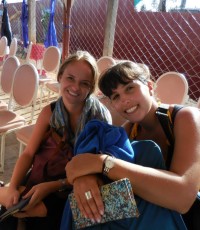
Meredith (left) at the Zanzibar airport, returning from the PiAf East Africa Fellows’ regional meetup with fellow Uganda Fellow Nava Friedman.
My fellowship with eleQtra in Kampala, from A to Z:
A – Acacia Mall: A new mall in Kampala at which I spend an embarrassing amount of time.
B – Boxing Gym: Two doors down from my house, the “East Coast” Boxing Gym provides the most grueling workout of my life for only $3.40 an hour.
C – Chokh Di Thai: I order from this restaurant so often that they answer my calls with “Hi Meredith!” and call me (often more than once) after I’ve eaten to ensure that everything was up to standard.
D – Due Diligence: Much of my time working with eleQtra is spent conducting legal due diligence on various aspects of the firm’s projects in East Africa.
E – Enid: The best (and likely the only) five-day-a-week housekeeper I’ll ever have. Her best line so far: “You’re dressed like a Nigerian!”
F – Fred: Kampala’s most reliable boda driver and probably the person the most fascinated by Canada I’ve ever met.
G – Go-down: A charming, bumpy, and sometimes rather smelly little hill upon which I live in Kampala.
H – Herbert: Our mysterious landlord. I still haven’t seen proof that he actually exists.
I – Infrastructure Development: eleQtra’s line of business. A fascinating and important – though often frustrating – area of work I’ve learned a lot about.
J – Jinja: The source of the Nile in Eastern Uganda. I have fond memories of weekends spent here with friends and an unexpectedly good Mexican restaurant.
K – Kalangala Infrastructure Services: One of eleQtra’s projects in Uganda, KIS provides electricity, ferry and road transport, and clean water.
L – London: I travelled to eleQtra’s annual workshops in London to present on sub-Saharan African Public Private Partnerships Acts with eleQtra’s Legal Director.
M – Mosque: The mosque near my house provides the most useful landmark to confused boda drivers. It also provides a raucous call to prayer every morning at 5:30.
N – Nairobi Commuter Rail Project: An eleQtra project whose (very complicated) legal aspects I’ve spent a lot of time working on.
O – Oil: A hot topic in Uganda since it was first discovered in 2006.
P – Public Private Partnerships Act: Legislation enacted to govern PPPs in many Sub-Saharan African countries. The impending Ugandan Act has occupied much of my time at eleQtra.
Q – Qualicel Bus Terminal: The chaotic starting location of many journeys.
R – Running: Evening runs through the hills of Naguru.
S – Serengeti: Safari with my parents in the Serengeti was a highlight of my year.
T – Tugende: “Let’s Go!” in Luganda – how many boda rides begin.
U – Ugandan food: So many beans, so much matoke.
V – Viber: Mobile calling app I use to call my boss in New York and friends/family in the US/Canada.
W – Weather: Kampala weather is perfection.
X – (E)Xchange Rate: The weak Shilling and strong US dollar have been advantageous for the stipend-dependent.
Y – Yelling Preacher: The enthusiastic and somewhat hostile-sounding preacher whose yells greet me every weekend morning.
Z – Zanzibar: The warm and sunny location of the PiAf East Africa Fellows’ regional meetup in November.
Notes from the Field
By Jennifer Umberg, 2014-15 Fellow with UN World Food Programme in South Africa
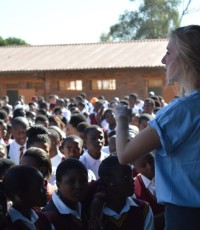
Jenn speaking to high-schoolers in Soweto, Johannesburg, South Africa about the UN system and food security.
I remember cringing at my suitcase the night before I left my home in Los Angeles’ suburbs. The Poisonwood Bible’s “the things we carried” mockingly echoed through my head. While I chuckled at the characters in the book packing their suitcases for Africa full of Betty Crocker cake mix and enough Band-Aids to service a kindergarten classroom, I figured my case was different: Johannesburg is a war zone that makes Compton look like Disneyland. I packed my (first ever) black beanie, alarm doorstop, bra “secret stash” sachet, duct tape, dark hoodie, large pocket knife… I quickly realized during my first few months in Johannesburg that my perceptions, and thus the things I thought I needed to carry, had been grossly misinformed. While crime is still a very gripping reality in Johannesburg, for every danger-ridden stereotype of the city there are several gems to challenge them. Here are some that I’ve picked up on in my seven months so far:
+ Fences really are everywhere – nine feet of stone with barbed wire separating houses in every neighborhood. However, public spaces are vibrant and welcoming. Moments running to Zoo Lake to join a barbeque, or eating falafel and listening to music in Joburg’s downtown markets amongst South Africa’s diverse young generation, have given me a new appreciation for the presence of others.
+ Some of Joburg’s inhabitants have been dispossessed, marginalized, evicted, and have started inhabiting spaces rife with drugs and local gangs. Yet, I’ve been inspired by a bubbling sense of activism amongst my young South African counterparts working on various social justice issues and talking politics with a sense of engagement and awareness that their generation’s role will have in determining South Africa’s social fabric. Even my dance studio has its own non-profit partnership teaching children from local child-headed households and mentoring formerly trafficked girls!
+ The shiny and safe-looking parts of Johannesburg aren’t free of crime either. However, Johannesburg has an incredible art scene (viewable just driving through the city’s graffiti’d streets!) that seems to unify its inhabitants in unexpected ways and sing songs of resilience. For the “smash-and-grab” thefts in Sandton – the “richest square mile in Africa” – there are art shows in Alexandra township hosted by people who have converted their homes into welcoming galleries for a day.
As I’ve realized my misconceptions about Johannesburg were not only incomplete but incorrect, I’ve seen WFP in Southern Africa also try to reshape many people’s perception that addressing hunger is only just providing food assistance. To ensure one meets the minimum daily caloric requirements is just one step in the process of becoming “food secure.” Being free to choose one’s own nutritional intake, to access markets, and to live without fear of disruptive climate shocks, though perhaps not realized by the public, are all parts of this process. Similarly, I didn’t realize that meeting my basic security needs in Johannesburg was just one step in trying to create a thriving life in South Africa.
I don’t know what I will carry with me on my next journey, in part because I’ve learned through my time here that you’ll never really know a location (or a development issue) until you delve into it. However, I’m certain that I’ll pocket and cherish the memories from my fellowship year for a lifetime.





